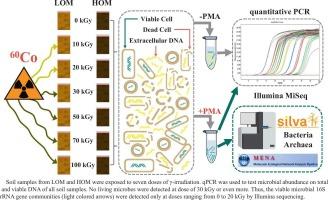Response of viable microbial communities to gamma irradiation in agricultural black soils
IF 5
2区 农林科学
Q1 SOIL SCIENCE
引用次数: 0
Abstract
Gamma (γ) irradiation is an effective means of sterilization, however, the response of viable microbial diversity and community structure to γ-irradiation in the distinct contents of soil organic matter (SOM) remains unclear. In this study, viable microbial abundance and community structure in a low organic matter soil (LOM) and a high organic matter soil (HOM) exposed to 0, 10, 20, 30, 50, 70, and 100 kGy doses of γ-irradiation were examined using quantitative PCR (qPCR) and Illumina MiSeq sequencing methods, respectively, after soils treated with DNA-intercalating dye propidium monoazide (PMA). The results showed that the soil microbial abundances were significantly reduced with the increase of γ-irradiation doses, with no detection in both soils at dose of 30 kGy or even more. We detected the sterilizing dose for LOM and HOM soil were 30 kGy and 20 kGy, respectively. The viable bacterial diversity after treated with PMA increased with radiation dose in both soils, but the viable archaeal diversity did not change significantly in the LOM soil. Moreover, γ-irradiation significantly changed the viable microbial community structure and its effect on bacterial community was greater than on archaeal community. The relative abundance of the viable Bacillota and Chloroflexota in both soils were significantly increased at radiation doses of 10 kGy and 20 kGy. However, the relative abundance of the viable archaeal class Nanoarchaeia and Nitrosophaeria did not change at the 10 kGy dose in LOM soil. Moreover, network analysis revealed that γ-irradiation altered the coexistence of viable archaea and bacteria in the soil, stabilized viable microbial networks and activated some radiation resistant viable microbes. This experiment provides important insights into the understanding of the response of viable microorganisms to γ-irradiation in different organic soils and provides a scientific basis for the development of soil disinfection technologies.

农业黑土中活菌群落对γ辐射的响应
γ (γ)辐照是一种有效的杀菌手段,但不同含量土壤有机质(SOM)中活菌多样性和群落结构对γ辐照的响应尚不清楚。本研究采用定量PCR (qPCR)和Illumina MiSeq测序方法,研究了低有机质土壤(LOM)和高有机质土壤(HOM)在0、10、20、30、50、70和100 kGy剂量γ辐照下,经dna插层染料单叠氮丙啶(PMA)处理后的活菌丰度和群落结构。结果表明,随着γ辐照剂量的增加,土壤微生物丰度显著降低,在30 kGy及更大剂量下,两种土壤均未检测到微生物丰度。我们检测到对LOM和HOM土壤的灭菌剂量分别为30 kGy和20 kGy。PMA处理后两种土壤的活菌多样性均随辐射剂量增加而增加,但LOM土壤的活古菌多样性变化不显著。此外,γ辐照显著改变了活菌群落结构,对细菌群落的影响大于对古细菌群落的影响。在10和20 kGy辐射剂量下,两种土壤中杆状菌和氯氟菌的相对丰度均显著增加。而在10 kGy剂量下,土壤中活古菌类纳米古菌和亚硝化古菌的相对丰度没有变化。此外,网络分析显示,γ辐照改变了土壤中活菌和细菌的共存,稳定了活菌网络,激活了一些抗辐射活菌。本实验为了解不同有机土壤中活菌对γ辐射的响应提供了重要的见解,并为土壤消毒技术的发展提供了科学依据。
本文章由计算机程序翻译,如有差异,请以英文原文为准。
求助全文
约1分钟内获得全文
求助全文
来源期刊

Applied Soil Ecology
农林科学-土壤科学
CiteScore
9.70
自引率
4.20%
发文量
363
审稿时长
5.3 months
期刊介绍:
Applied Soil Ecology addresses the role of soil organisms and their interactions in relation to: sustainability and productivity, nutrient cycling and other soil processes, the maintenance of soil functions, the impact of human activities on soil ecosystems and bio(techno)logical control of soil-inhabiting pests, diseases and weeds.
 求助内容:
求助内容: 应助结果提醒方式:
应助结果提醒方式:


